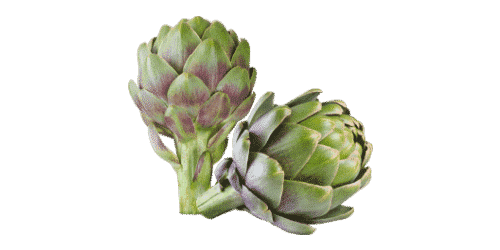
Origin
Originating from the Mediterranean areas, the artichoke has been consumed since ancient times by the Greeks and Romans. A descendant of the wild thistle, its diuretic properties were first employed by the Arabs. In France, it has been used since the Middle Ages for promoting secretion of the bil and relieving liver disorders.
Did you know?
The artichoke was introduced for the first time in the sixteenth century in France of the table of Queen Catherine de Médicis. It also became and indulgence of Louis XIV thanks to its delicate taste. Louis XIV appreciated it so much that five different species of artichoke were grown in Versailles during the reign of the Sun King: White, Green, Purple, Red and Sweet Artichoke of Genes. As artichokes were considered a favourite of the French, the Brittany Camus artichoke was introduced in 1810.
Characteristics
The artichoke has a stem that can grow up to 1.50 m in height. It is straight and thick with large leaves. The outer layers are green and the inner layers are whitish and soft. Its purple flower grows above the bud which is consumed. The small leaves that make up the head of the artichoke are called bracts. These are used in phytotherapy.
Cultivation and harvesting
The artichoke is cultivated across western Europe. In France, artichoke crops are grown in particular in Brittany and Provence. The plant loves to be exposed to the sun but does however require a regular watering. Although the artichoke can withstand temperatures of up to -10°C, it is preferable to protect it from the cold. The bracts are harvested before the the flower appears and preferably in summer. They can then be dried and ground for use in phytotherapy.
Benefits
The physiotherapist properties of the artichoke have been recognised since the start of the twentieth century. It is known for being very low in calories and is composed of various proteins, fibres, carbohydrates, antioxidants, minerals and vitamins such as magnesium, iron vitamin C .
Eating articho9ke:
- Helps eliminate toxins
The quantity of potassium contained in the artichoke plays an important role in the body’s drainage. It therefore helps to combat water retention and to detoxify the body by eliminating toxins that build up daily.
- Promotes digestive transit
The bracts naturally contain a substance called czarina which stimulates the production of bile. The increase in bile production strengthens the function of the liver and gall bladder. The artichoke promotes therefore the healthy functioning of the digestive system.
- Aids in the reduction of the cholesterol level
The czarina derived from the bracts also has the capacity to reduce the level of cholesterol and fatty acids in the blood.
Plant-based health: 200 plants with health benefits Reader’s Digest selection, 2003. 352 p. ISBN 2-7098-1413-7
